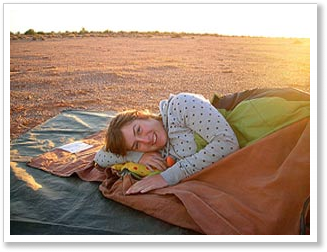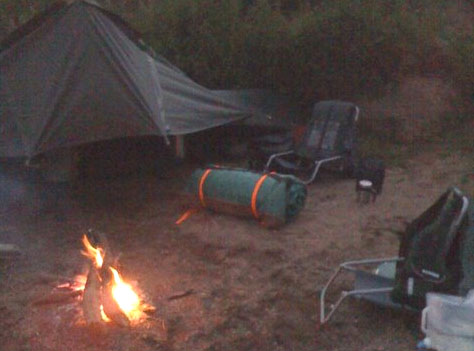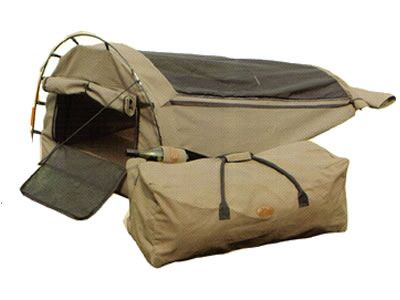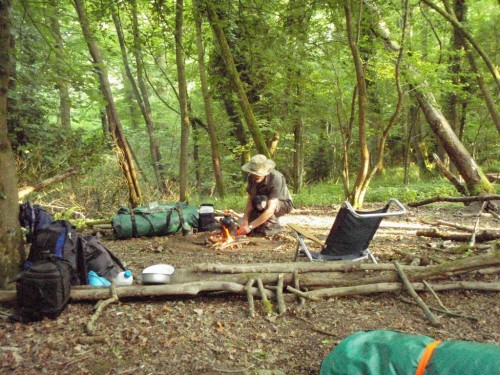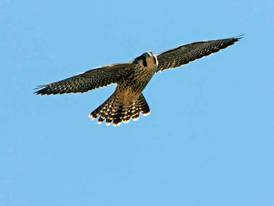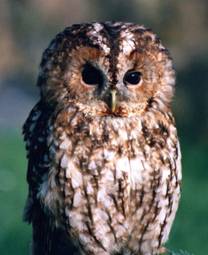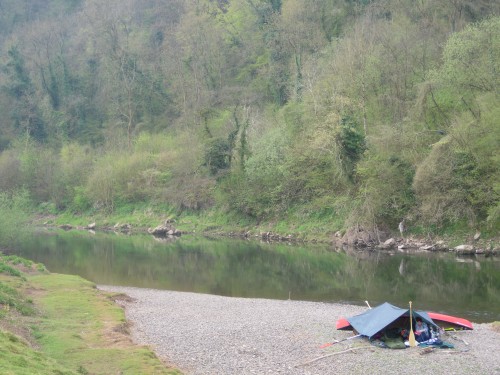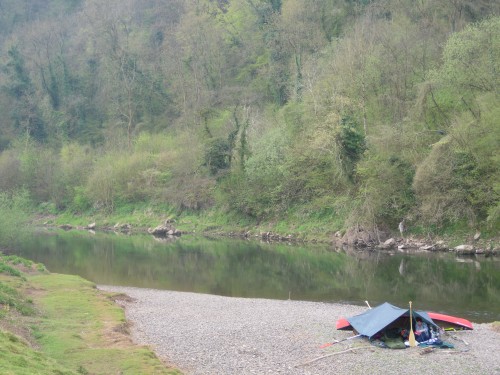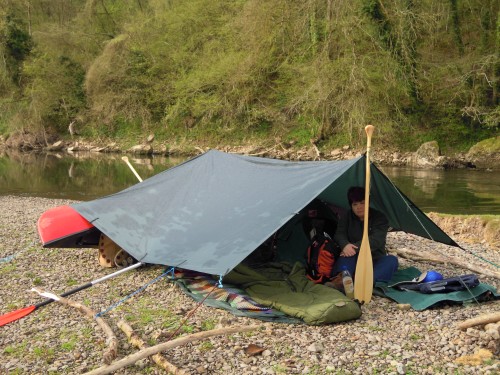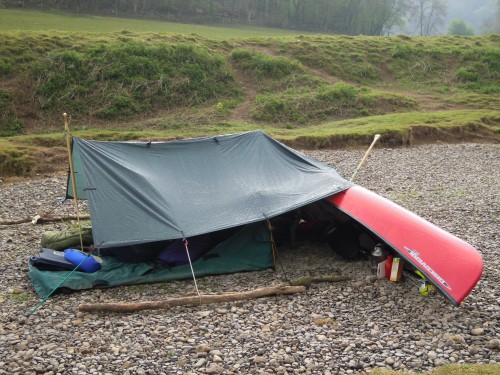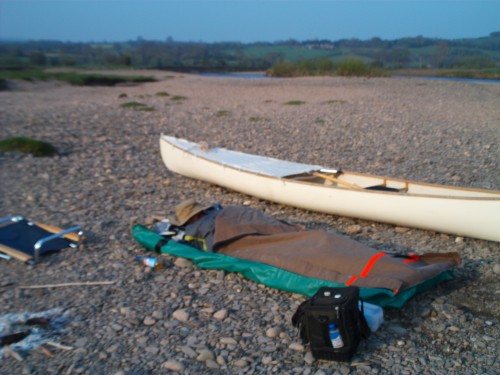I’m a huge fan of “bedroll camping” – camping out under the stars around the camp fire in a traditional canvas Australian-style “swag” or bedroll – see my previous post here. I’ve been fascinated by these and have gradually been delving deeper into the history to this unique way of camping, that seems more or less unknown as such outside Australia, although North America has it’s “cowboy bedroll”, and the British army during WWII had the officer’s bedroll and now of course we have the modern “bivvy bag”, but it’s not quite the same thing. So my research has come up with some fantastic historical details which I have compiled in this feature, covering the origins of the word, of the Australian swag in 19th Century Australia, and use of the swag in the 20th Century and up to the present day modern swags used in Australia.
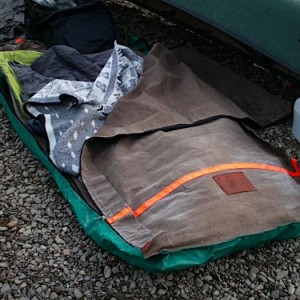
The Swag in use on a frosty UK Canoe Camp trip
In Australian historical terms, a swag is basically a waterproof bedroll. In the 1800s and first half of the 20th century a swagman was an itinerant rural worker – usually but not always sheep shearers – who carried their bedroll ‘swag’ with their belongings wrapped in them on their back. Most modern swags however are only used for bedding, but they are typically made with a waterproof outer section – traditionally canvas but more recent swags use more modern materials. Before motor transport was common, foot travel over long distances was essential to workers who were travelling in the Australian bush and who could not afford a horse. Itinerant workers who travelled from farm to farm sheep shearing in the late 19th and early 20th centuries were called “swagmen” because they carried all their possessions in a swag. This image was immortalised in Australian culture by the song Waltzing Matilda.
A swag is also referred to as a “Matilda”, “Drum” or “Bluey” and hence “Waltzing matilda”, “walking along with my swag” (from the German auf der Walz, which means to travel while working as a craftsman) “humping bluey”. Bluey refers to the favoured blue color of cloth blankets used in the bedrolls. The word Swag itself appears to come from old norse word for “swing” or thing that “swings or sways”, can also be applied to a person’s gait as they carry something, swaying along. This word can be found in recored use back as far at the 11th century.
The most detailed 19th Century Australian description of the swag is found in Henry Lawson’s The Romance of the Swag:
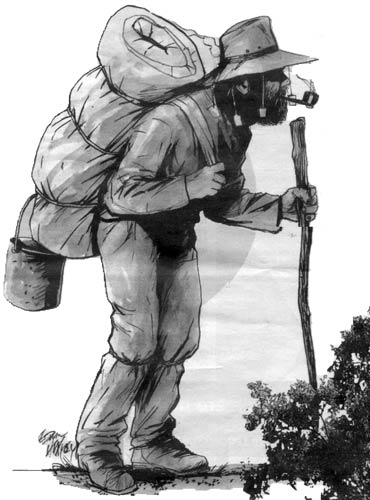
The Jolly Swagman in “Waltzing Matilda” – Australia’s unofficial National Anthem
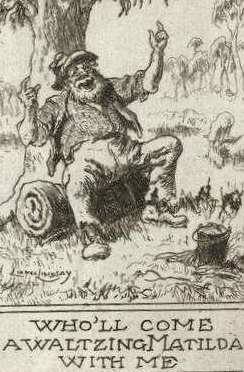
Jolly Swagman, sitting on his swag: A drawing illustrating the famous Australian folk song Waltzing Matilda
“Waltzing Matilda” is Australia’s most widely known bush ballad, a country folk song, and has been referred to as “the unofficial national anthem of Australia”. The song narrates the story of an itinerant worker, or swagman, making a drink of tea at a bush camp and capturing a sheep to eat. When the sheep’s ostensible owner arrives with three police officers to arrest the worker for the theft (a crime punishable by hanging), the worker commits suicide by drowning himself in the nearby watering hole, and then goes on to haunt the site.
Waltzing Matlida
by Bajo Paterson
Once a jolly swagman camped by a billabong
Under the shade of a coolabah tree,
And he sang as he watched and waited ’til his billy boiled
“You’ll come a-Waltzing Matilda, with me”
Full lyrics and background info here.
With a Swag Upon My Shoulder, Black Billy in my Hand….
Another folk song featuring the swag is “With a Swag Upon My Shoulder” (the tune being a variant of the Irish tune ‘Boys of Wexford’).
http://folkstream.com/100.html
With my Swag upon my Shoulder
When first I left Old England’s shore
Such yarns as we were told
As how folks in Australia
Could pick up lumps of gold
So, when we got to Melbourne town
We were ready soon to slip
And get even with the captain
All hands scuttled from the ship
Chorus
With my swag all on my shoulder
Black billy in my hand
I travelled the bush of Australia
Like a true-born Irish man
And so on, the full lyrics are here, a great bush song.
Use of Swags – late 20th Century
From http://www.our-camping-site.com/swags.html

Swag rolled up on top of an old Bedford truck - photo c1979
This photo from 1979 from www.our-camping-site.com shows a swag rolled up on the back of an old Bedford truck, way out in the bush, where the driver pictured had slept out in the swag right on the road itself – the author notes that you could do that back in the days when there was less trafic in these remote areas, but suggests ‘Of course, camping on any road today would not be a sensible thing to do’!
Contemporary Swag Stories
A party travelling through outback Australia describe the experience of renting a swag for the trip: Extract from: http://www.kia-sorento.org/swag.html “The swag, during those four days of driving along the Mereenie loop road, has been a staple of fun and tease among us. A swag is quite a comfortable bed that can be rolled and carried fairly easily. But the swag proved to have a couple of drawbacks, such as its renting price (150 Australian dollars apiece for 4 days), and its size, making it a bit bulky. However, facing the difficulty of accommodating everyone’s comfort needs, one swag was rented for one of us, while two would sleep in the tent, and the remaining two would sleep on a sleeping mat.

The swag being rolled up after a nights stop
The cold (and mosquitoes) of the first night forced the two mat-sleepers to seek refuge into the Kia, and the two tent-sleepers to hug each other even closer (the next day sleeping bags were bought for those four unfortunate), while the swag-sleeper enjoyed a cold-free and almost mosquito-free night, and awoke with morale at its highest.
Tourist Swag camping – Swag Safaris & The Ghost of the Jolly Swagman…
Many tour companies now offer a nights swag camp in the Australain desert as a way to experience ‘the real Australian outback’ offered alongside snorkelling the Great Barrier Reef and other popular Australian tourist experiences:
“Sleep in a bush swag near Ayers Rock, snorkel the Great Barrier Reef and spot dolphins in the Wild West. Our friendly travel specialists will help you build a completely personal Australia trip with our unique bite-sized experiences, including ‘Coral Sea Meets Rainforest’, ‘Rock to Croc Safari’ and ‘Put Your Feet Up At Mission Beach’. Simply choose the mini-adventures that catch your eye and we’ll string them together using a mix of local and private transport.”
From: Australia Travel Plan
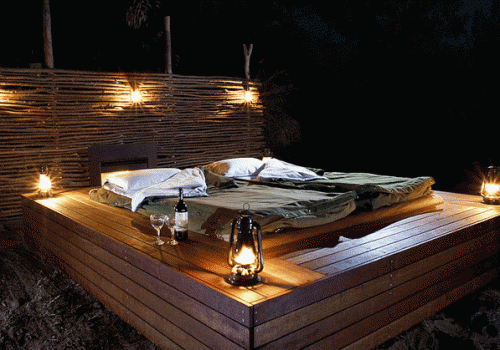
A Boutique luxury swag camp!
There’s even boutique hotel “swag” experiences available, such as this Blue Mountain Private Safaris Luxury Swag Camp although that comes at some cost, a world away from the original “swagman” experience! I imagine the ghost of the jolly Swagman of “Waltzing Matilda” roaming around humping his drum, and wearily wandering into one of these luxury swag hotel-camps! I reckon he’d set about making him self right at home, feasting on $200 bottles of wine and asking for more fresh towels – after a few days rest and gourmet tucker, our ghost would have to grab his old swag he left at the door, and head off into the bush again of course, perhaps with a bunch of miniature whisky bottles from the mini bar in his swag!
Ray Mears, Bushcraft & the Swag
Someone who has travelled and wild-camped all over the world is the UK bushcraft expert, writer and TV presenter Ray Mears. A proponent of swag camping and it’s benefits, Ray has featured swags in several of his programmes. Here’s Ray in a swag in the desert.
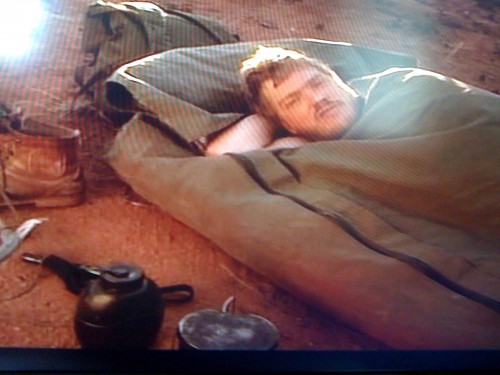
Ray Mears, the bushcraft swagman...
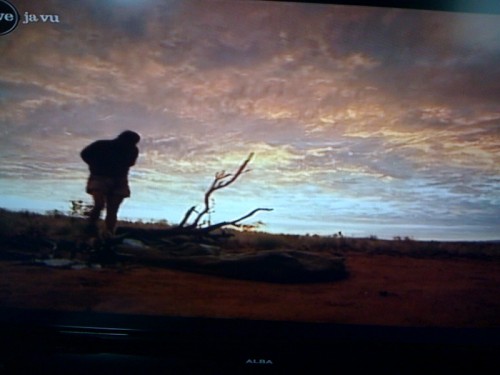
Beautiful desert swag camp scene
Modern Design Australian Swags
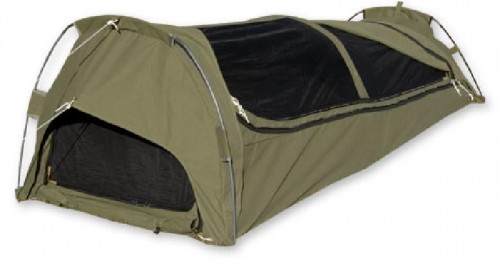
A modern Australian canvas 'dome' swag
Often made with PVC base, witha lot of features like mozzie nets, vecro, storm flaps and comfortable mattresses, these come in many designs and colours and shapes, most now being offered with a hooped ‘dome’ design, such as the Waratah from Burke & Wills. Here’s a video of me from LandRoverExplorer.co.uk of the Waratah swag being set up:
Swags used on Path Of The Paddle
The Razorback swag used on many canoeing and wild-camping trips featured on this website
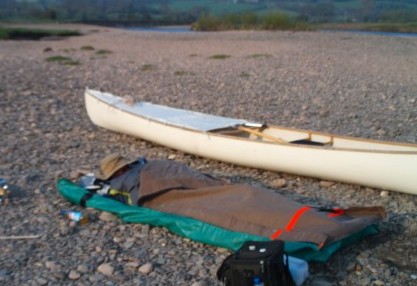
Wild camping with a swag in the U.K.
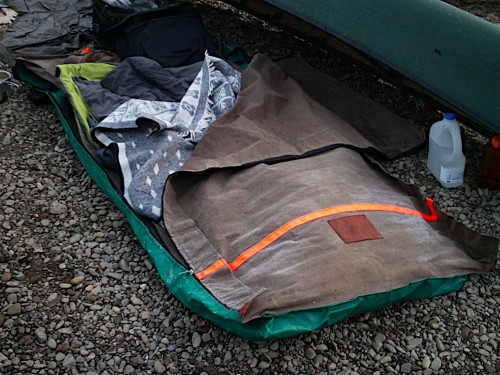
Frost on the swag - sleeping bag and a wool mexican blanket in the swag let's you sleep out in sub-zero temperatures with no problem
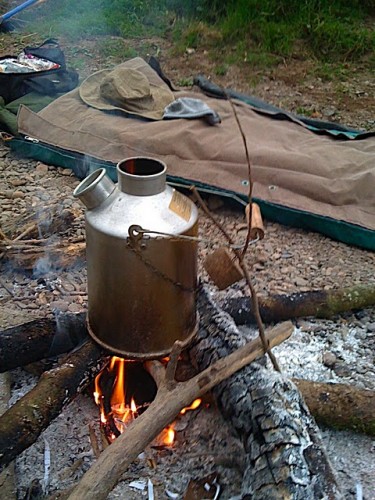
Waiting for the Billy to Boil... Swag next to the camp fire
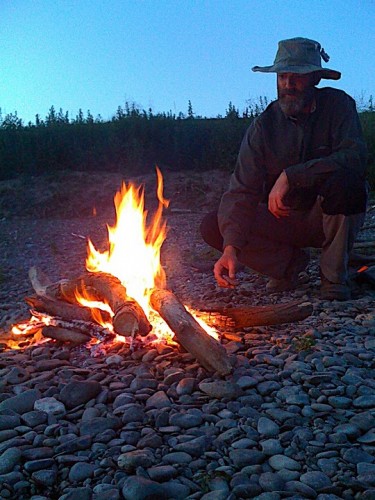
Talking some old lead.... around the camp fire...
Got a Swag Story?
Got your own Swag camp stories? Or know of any more historical background we could add here? Let us know using the form here. Thanks!

